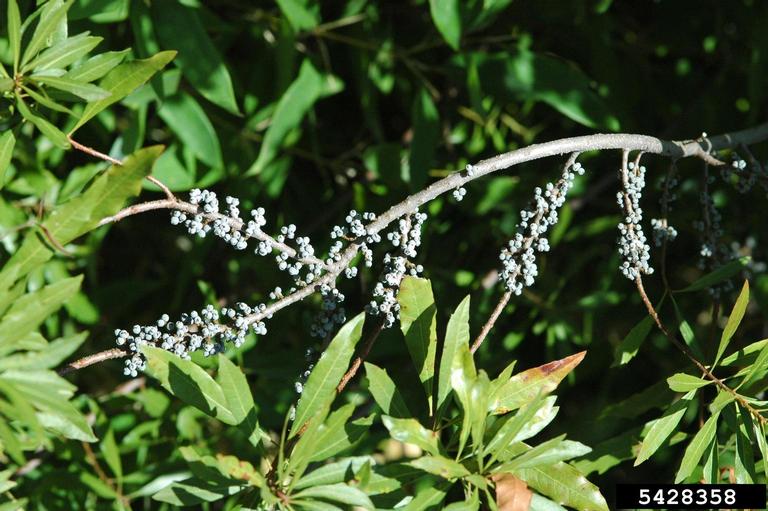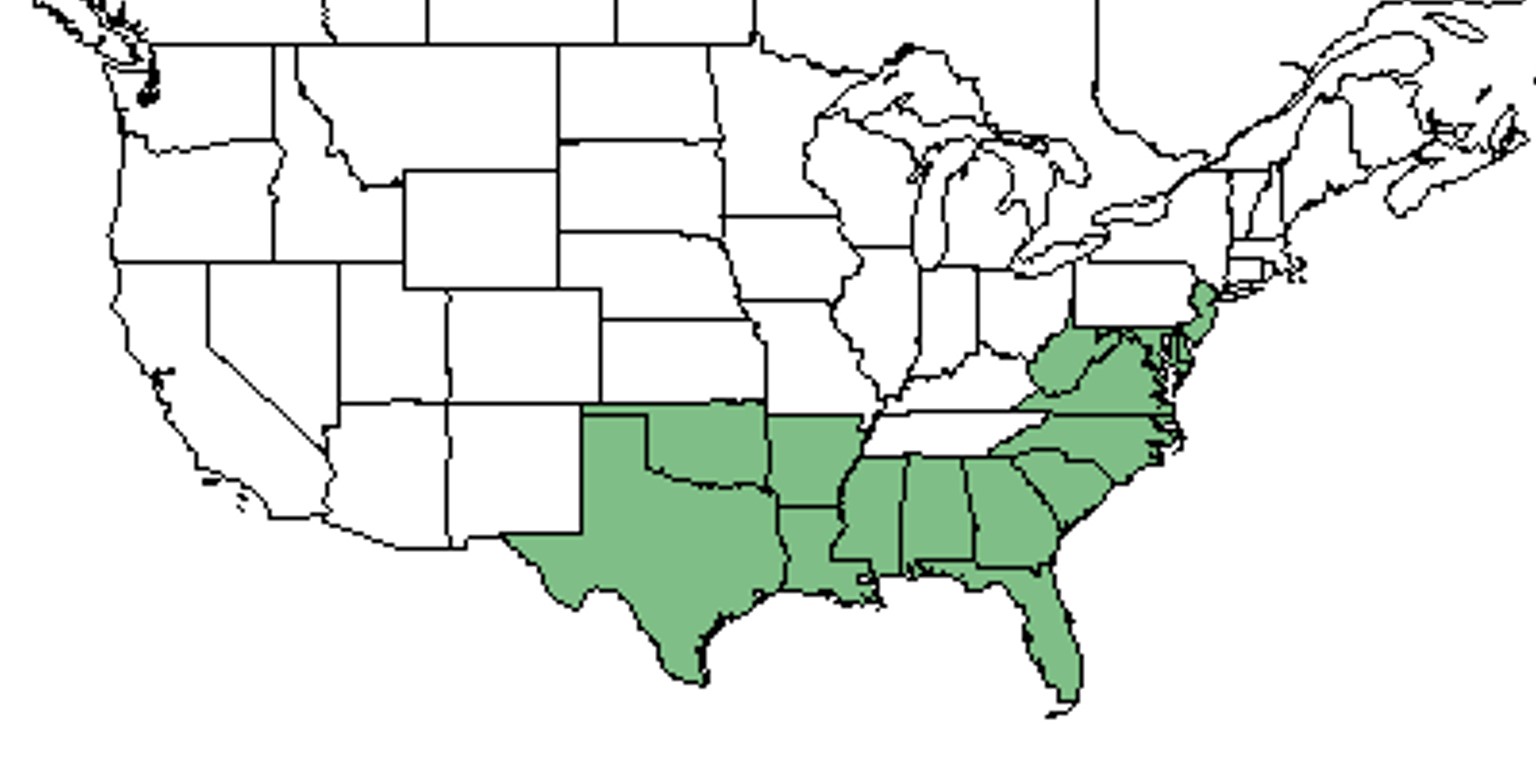Difference between revisions of "Morella cerifera"
Juliec4335 (talk | contribs) |
Emmazeitler (talk | contribs) |
||
| Line 20: | Line 20: | ||
Common names: Common waxmyrtle; Southern bayberry | Common names: Common waxmyrtle; Southern bayberry | ||
==Taxonomic notes== | ==Taxonomic notes== | ||
| − | Synonyms: ''Myrica cerifera'' L.; ''Myrica cerifera'' Linnaeus var. ''cerifera'' | + | Synonyms: ''Myrica cerifera'' L.; ''Myrica cerifera'' Linnaeus var. ''cerifera''; ''Cerothamnus ceriferus'' (Linnaeus) Small.<ref name="weakley">Weakley, A.S. 2015. Flora of the southern and mid-atlantic states. Working Draft of 21 May 2015. University of North Carolina at Chapel Hill, Chapel Hill, North Carolina.</ref> |
| + | |||
| + | Varieties: none.<ref name="weakley">Weakley, A.S. 2015. Flora of the southern and mid-atlantic states. Working Draft of 21 May 2015. University of North Carolina at Chapel Hill, Chapel Hill, North Carolina.</ref> | ||
==Description== | ==Description== | ||
<!-- Basic life history facts such as annual/perrenial, monoecious/dioecious, root morphology, seed type, etc. --> | <!-- Basic life history facts such as annual/perrenial, monoecious/dioecious, root morphology, seed type, etc. --> | ||
| − | "Dioecious or monoecious shrubs or small trees, with brown to brownish-black, pubescent to glabrate twigs. Leaves deciduous or semi-evergreen, coriaceous, petiolate, exstipulate. Staminate catkins ovoid-cylindric, 0.6-2 cm long, 4-6 mm in diam.; bracteate and bracteolate; stamens 2-1, mostly 2-5. Pistillate catkins ovoid or cylindric, 5-10 mm long, deciduous-bracteate. Fruits drupaceous, white, globose, verrucose, 2.5-7 mm in diam. A taxonomically difficult group with intergrading species." <ref name="Radford et al 1964">Radford, Albert E., Harry E. Ahles, and C. Ritchie Bell. Manual of the Vascular Flora of the Carolinas. 1964, 1968. The University of North Carolina Press. 360. Print.</ref> | + | "Dioecious or monoecious shrubs or small trees, with brown to brownish-black, pubescent to glabrate twigs. Leaves deciduous or semi-evergreen, coriaceous, petiolate, exstipulate. Staminate catkins ovoid-cylindric, 0.6-2 cm long, 4-6 mm in diam.; bracteate and bracteolate; stamens 2-1, mostly 2-5. Pistillate catkins ovoid or cylindric, 5-10 mm long, deciduous-bracteate. Fruits drupaceous, white, globose, verrucose, 2.5-7 mm in diam. A taxonomically difficult group with intergrading species."<ref name="Radford et al 1964">Radford, Albert E., Harry E. Ahles, and C. Ritchie Bell. Manual of the Vascular Flora of the Carolinas. 1964, 1968. The University of North Carolina Press. 360. Print.</ref> |
| − | "Shrub or small tree, 0.3-7 m tall. Leaves oblanceolate or elliptic, to 8 cm long and 2cm wide, heavily resinous on both surfaces, usually pubescent beneath, acute or obtuse, serrate or entire, base cuneate to attenuate, petioles to 1 cm long. Fruits 2.5-3.5 mm in diam." <ref name="Radford et al 1964"/> | + | "Shrub or small tree, 0.3-7 m tall. Leaves oblanceolate or elliptic, to 8 cm long and 2cm wide, heavily resinous on both surfaces, usually pubescent beneath, acute or obtuse, serrate or entire, base cuneate to attenuate, petioles to 1 cm long. Fruits 2.5-3.5 mm in diam."<ref name="Radford et al 1964"/> |
==Distribution== | ==Distribution== | ||
| − | Is found within the Coastal Plain and as far north as New Jersey. <ref name="Weakley 2015">Weakley, Alan S. Flora of the Southern and Mid-Atlantic States: Working Draft of 21 May 2015. University of North Carolina Herbarium (NCU). PDF. 644.</ref> | + | Is found within the Coastal Plain and as far north as New Jersey.<ref name="Weakley 2015">Weakley, Alan S. Flora of the Southern and Mid-Atlantic States: Working Draft of 21 May 2015. University of North Carolina Herbarium (NCU). PDF. 644.</ref> |
==Ecology== | ==Ecology== | ||
===Habitat=== <!--Natural communities, human disturbed habitats, topography, hydrology, soils, light, fire regime requirements for removal of competition, etc.--> | ===Habitat=== <!--Natural communities, human disturbed habitats, topography, hydrology, soils, light, fire regime requirements for removal of competition, etc.--> | ||
| − | + | The species is naturally found in interdune swales, pocosins, brackish marshes, and other wet to moist habitats.<ref name="Weakley 2015"/> Is widely planted as an ornamental or as a landscaping shrub.<ref name="Weakley 2015"/> | |
| − | ''M. cerifera'' responds positively to agricultural-based soil disturbance in South Carolina | + | ''M. cerifera'' responds positively to agricultural-based soil disturbance in South Carolina Coastal Plain communities. This marks it as an indicator species for post-agricultural woodland.<ref>Brudvig, L.A., E Grman, C.W. Habeck, and J.A. Ledvina. (2013). Strong legacy of agricultural land use on soils and understory plant communities in longleaf pine woodlands. Forest Ecology and Management 310: 944-955.</ref> However, ''M. cerifera'' responds negatively to heavy silviculture in North Florida<ref>Conde, L.F., B.F. Swindel, and J.E. Smith. (1986). Five Years of Vegetation Changes Following Conversion of Pine Flatwoods to ''Pinus elliottii'' Plantations. Forest Ecology and Management 15(4):295-300.</ref> and both positively and negatively to soil disturbance by clearcutting and roller chopping in North Florida.<ref>Lewis, C.E., G.W. Tanner, and W.S. Terry. (1988). Plant responses to pine management and deferred-rotation grazing in north Florida. Journal of Range Management 41(6):460-465.</ref> It also responds negatively to soil disturbance by clearcutting and chopping in North Florida flatwoods forests.<ref>Moore, W.H., B.F. Swindel, and W.S. Terry. (1982). Vegetative Response to Clearcutting and Chopping in a North Florida Flatwoods Forest. Journal of Range Management 35(2):214-218.</ref> ''M. cerifera'' responds negatively to soil disturbance by roller chopping and negatively or not at all to disturbance by a KG blade in East Texas Loblolly Pine-Hardwood Forests.<ref>Stransky, J.J., J.C. Huntley, and Wanda J. Risner. (1986). Net Community Production Dynamics in the Herb-Shrub Stratum of a Loblolly Pine-Hardwood Forest: Effects of CLearcutting and Site Preparation. Gen. Tech. Rep. SO-61. New Orleans, LA: U.S. Dept of Agriculture, Forest Service, Southern Forest Experiment Station. 11 p.</ref> |
''Morella cerifera'' is frequent and abundant in the Calcareous Savannas community type as described in Carr et al. (2010).<ref>Carr, S.C., K.M. Robertson, and R.K. Peet. 2010. A vegetation classification of fire-dependent pinelands of Florida. Castanea 75:153-189.</ref> | ''Morella cerifera'' is frequent and abundant in the Calcareous Savannas community type as described in Carr et al. (2010).<ref>Carr, S.C., K.M. Robertson, and R.K. Peet. 2010. A vegetation classification of fire-dependent pinelands of Florida. Castanea 75:153-189.</ref> | ||
===Phenology=== <!--Timing off flowering, fruiting, seed dispersal, and environmental triggers. Cite PanFlora website if appropriate: http://www.gilnelson.com/PanFlora/ --> | ===Phenology=== <!--Timing off flowering, fruiting, seed dispersal, and environmental triggers. Cite PanFlora website if appropriate: http://www.gilnelson.com/PanFlora/ --> | ||
| − | + | This species flowers in April and fruits from August to October.<ref name="Weakley 2015"/> | |
<!--===Seed dispersal===--> | <!--===Seed dispersal===--> | ||
<!--===Seed bank and germination===--> | <!--===Seed bank and germination===--> | ||
Revision as of 18:14, 28 September 2020
| Morella cerfiera | |
|---|---|

| |
| Photo by Karan A. Rawlins, University of Georgia, Bugwood.org | |
| Scientific classification | |
| Kingdom: | Plantae |
| Division: | Tracheophyta- Vascular plants |
| Class: | Magnoliopsida – Dicotyledons |
| Order: | Fagales |
| Family: | Myricaceae |
| Genus: | Morella |
| Species: | M. cerfiera |
| Binomial name | |
| Morella cerfiera (L.) Small | |

| |
| Natural range of Morella cerfiera from USDA NRCS Plants Database. | |
Common names: Common waxmyrtle; Southern bayberry
Contents
Taxonomic notes
Synonyms: Myrica cerifera L.; Myrica cerifera Linnaeus var. cerifera; Cerothamnus ceriferus (Linnaeus) Small.[1]
Varieties: none.[1]
Description
"Dioecious or monoecious shrubs or small trees, with brown to brownish-black, pubescent to glabrate twigs. Leaves deciduous or semi-evergreen, coriaceous, petiolate, exstipulate. Staminate catkins ovoid-cylindric, 0.6-2 cm long, 4-6 mm in diam.; bracteate and bracteolate; stamens 2-1, mostly 2-5. Pistillate catkins ovoid or cylindric, 5-10 mm long, deciduous-bracteate. Fruits drupaceous, white, globose, verrucose, 2.5-7 mm in diam. A taxonomically difficult group with intergrading species."[2]
"Shrub or small tree, 0.3-7 m tall. Leaves oblanceolate or elliptic, to 8 cm long and 2cm wide, heavily resinous on both surfaces, usually pubescent beneath, acute or obtuse, serrate or entire, base cuneate to attenuate, petioles to 1 cm long. Fruits 2.5-3.5 mm in diam."[2]
Distribution
Is found within the Coastal Plain and as far north as New Jersey.[3]
Ecology
Habitat
The species is naturally found in interdune swales, pocosins, brackish marshes, and other wet to moist habitats.[3] Is widely planted as an ornamental or as a landscaping shrub.[3]
M. cerifera responds positively to agricultural-based soil disturbance in South Carolina Coastal Plain communities. This marks it as an indicator species for post-agricultural woodland.[4] However, M. cerifera responds negatively to heavy silviculture in North Florida[5] and both positively and negatively to soil disturbance by clearcutting and roller chopping in North Florida.[6] It also responds negatively to soil disturbance by clearcutting and chopping in North Florida flatwoods forests.[7] M. cerifera responds negatively to soil disturbance by roller chopping and negatively or not at all to disturbance by a KG blade in East Texas Loblolly Pine-Hardwood Forests.[8]
Morella cerifera is frequent and abundant in the Calcareous Savannas community type as described in Carr et al. (2010).[9]
Phenology
This species flowers in April and fruits from August to October.[3]
Conservation and management
Cultivation and restoration
Photo Gallery
References and notes
- ↑ 1.0 1.1 Weakley, A.S. 2015. Flora of the southern and mid-atlantic states. Working Draft of 21 May 2015. University of North Carolina at Chapel Hill, Chapel Hill, North Carolina.
- ↑ 2.0 2.1 Radford, Albert E., Harry E. Ahles, and C. Ritchie Bell. Manual of the Vascular Flora of the Carolinas. 1964, 1968. The University of North Carolina Press. 360. Print.
- ↑ 3.0 3.1 3.2 3.3 Weakley, Alan S. Flora of the Southern and Mid-Atlantic States: Working Draft of 21 May 2015. University of North Carolina Herbarium (NCU). PDF. 644.
- ↑ Brudvig, L.A., E Grman, C.W. Habeck, and J.A. Ledvina. (2013). Strong legacy of agricultural land use on soils and understory plant communities in longleaf pine woodlands. Forest Ecology and Management 310: 944-955.
- ↑ Conde, L.F., B.F. Swindel, and J.E. Smith. (1986). Five Years of Vegetation Changes Following Conversion of Pine Flatwoods to Pinus elliottii Plantations. Forest Ecology and Management 15(4):295-300.
- ↑ Lewis, C.E., G.W. Tanner, and W.S. Terry. (1988). Plant responses to pine management and deferred-rotation grazing in north Florida. Journal of Range Management 41(6):460-465.
- ↑ Moore, W.H., B.F. Swindel, and W.S. Terry. (1982). Vegetative Response to Clearcutting and Chopping in a North Florida Flatwoods Forest. Journal of Range Management 35(2):214-218.
- ↑ Stransky, J.J., J.C. Huntley, and Wanda J. Risner. (1986). Net Community Production Dynamics in the Herb-Shrub Stratum of a Loblolly Pine-Hardwood Forest: Effects of CLearcutting and Site Preparation. Gen. Tech. Rep. SO-61. New Orleans, LA: U.S. Dept of Agriculture, Forest Service, Southern Forest Experiment Station. 11 p.
- ↑ Carr, S.C., K.M. Robertson, and R.K. Peet. 2010. A vegetation classification of fire-dependent pinelands of Florida. Castanea 75:153-189.